MajaPhoto/iStock Editorial via Getty Images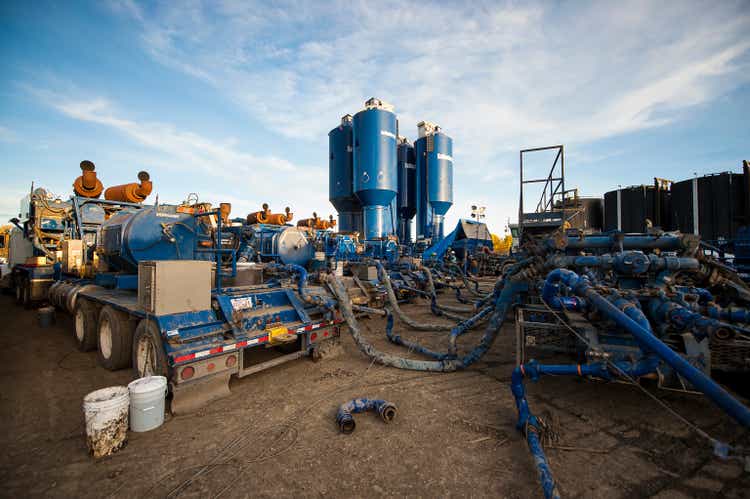
In a recent article, I stated investors should consider investing in the Montney natural gas play in western Canada, which is one of the world’s most significant resource plays; I then went on to enumerate a set of E&P companies that may give investors exposure to that play, stopping short of naming my best picks among these stocks.
Below, let’s first develop a simple yet powerful methodology for E&P stock screening and then use the technique to pick the top Montney pure-play stocks.
Screening E&P Stocks
“This is the persistent tendency of men to see only the immediate effects of a given policy, or its effects only on a special group, and to neglect to inquire what the long-run effects of that policy will be not only on that special group but on all groups. It is the fallacy of overlooking secondary consequences.” – Henry Hazlitt
Common Potholes
This article is as much concerning how to pick the best E&P stocks as about presenting any specific ideas.
A systematic methodology for screening energy stocks is extremely important for generalist investors who are new to the oil and gas industry and, for that reason, may fall for monofactorial decision-making.
- Monofactorial decisioning is the tendency for an investor to rely on one single factor to make a call on a rather complex investment idea, while ignoring numerous other relevant variables.
Furthermore, investors need a sound approach to analyze E&P stocks today more than ever, if only to guard against the gunslinging gurus who emerge on social media in number as the oil prices rise and prod starry-eyed investors to chase instant riches by plowing hard-earned money into stocks that feature the so-called torque, are heavily-indebted, and/or hedge an inadequate amount of production.
- A believer in torque sniffs around for stocks that supposedly deliver the maximum upside as the oil prices swing higher. A common catchphrase goes like “the stock will be worth Y when WTI reaches X”, which can be extremely effective in stoking unsophisticated buyer’s imagination of quick profit. Torque peddlers rarely spell out the underlying assumption that the model depends on a continually rising oil price; neither the perilous consequence when commodity prices inevitably turn against the holders of torquey stocks.
A Holistic Approach
At The Natural Resources Hub, we screen for E&P ideas by analyzing a number of operational parameters, and by integrating these variables in a holistic manner. The value of an oil and gas stock is expressed as a product of a valuation metric, e.g., EV/E*, and a measure of the profit, namely E*:
The market accords a valuation multiple to a stock depending on, e.g.:
- industry characteristics (e.g., cyclical or secular, growing or in terminal decline, ESG conforming or disagreeable),
- jurisdiction (fiscal regime, political stability, access to infrastructure and skilled labor),
- economics of the business (e.g., subsurface resource endowment, total commodity price realization, and cost structure),
- financial health of the business (e.g., balance sheet quality, commodity price risk management, and liquidity).
Further expanding on what I first presented in a previous interview, the profit pulled in by a business may be described as follows:
- E* = {[Realized price] – [OpEx] – [F&D]} X [Production] X {1 + g}, where OpEx is the full-cycle operating expenses, F&D is the cost to find and develop one barrel equivalent of oil and gas reserves, and g is the production growth rate.
The profitability of the business can thus be described as E*/[Production] = {[Realized price] – [OpEx] – [F&D]} X {1 + g}, where various operational parameters come together to determine the profitability of a business. This equation makes it possible to compare different oil businesses.
- A high [Realized price] has a positive impact on the profitability of the business. This depends not only on benchmark commodity prices but also on the composition of the production.
- The spread [Realized price] – [OpEx] is the full-cycle operating netback or margin. The ratio of operating netback over F&D is called the recycle ratio.
- Production growth drives not only increase in profit but also economies of scale, unit OpEx decline and margin expansion.
Analyzing Margins
Price Realization
The percentage of crude oil and especially condensate in total production is the main determinant of the price realized by a Montney operator. Condensate captures a premium over crude oil because there exists a strong demand for it from the Canadian oil sands producers. For example, over the past nine years, ARC Resources (OTCPK:AETUF) achieved a condensate-over-oil premium of C$0.31/bbl to C$10.96/bbl, averaging C$3.96/bbl (Fig. 1).
Fig. 1. Historical prices of liquids production realized by ARC Resources (Laurentian Research based on data sourced from Seeking Alpha and ARC Resources)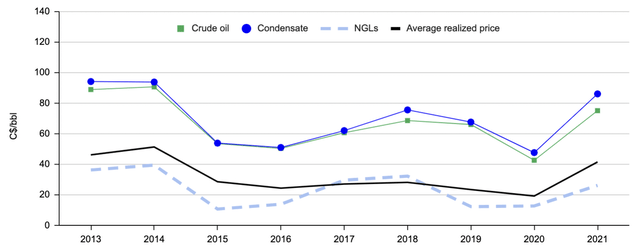
- It is thus necessary to compare the Montney producers with regard to their composition of production. NuVista Energy (OTCPK:NUVSF) and Pipestone Energy (OTCPK:BKBEF) lead the pack in condensate + crude cut and, consequently, realized prices of total production. ARC Resources is not far behind, while Crew Energy (OTCQB:CWEGF), Birchcliff Energy (OTCPK:BIREF) and especially Advantage Energy (OTCPK:AAVVF) lag behind in this aspect (Table 1).
Table 1. The composition of production and PDP reserves of Montney pure-play E&P companies (Laurentian Research compiled from Seeking Alpha and company financial filings)
Operating Costs
Advantage, ARC, Birchcliff and Crew were cost leaders in 2021, while NuVista and Pipestone were high in unit cash cost (above C$19/boe). Between the realized price and cash costs, ARC, Pipestone and NuVista pulled in the highest cash netbacks, with all six operators attaining a >50% cash margin (Table 2).
However, the relative ranking of margins of these companies may change in the near future:
- Judging from the mid-point 2022 guidance, Advantage, ARC and Birchcliff are projected to have flattish to higher unit cash costs this year.
- NuVista, Crew and Pipestone are expected to reduce unit cash cost through production growth-driven economies of scale. NuVista plans to grow production by 30% in 2022 to fill up its built-out infrastructure; Pipestone has an ambitious plan to hike production by 30%, 27%, and 12%, respectively, in the next three years; and Crew intends to pull off a >20% production in 2022. Consequently, Pipestone and NuVista may pull ahead in cash margins in the next few years.
Table 2. Cost structure and cash margins of Montney pure-play E&P companies (Laurentian Research based on data sourced from Seeking Alpha and company financial filings)
F&D Cost And Recycle Ratio
Advantage, Crew Energy and ARC Resources seem to be slightly ahead of Birchcliff, NuVista and Pipestone in terms of 1P F&D cost and recycle ratio (Table 3).
Table 3. The F&D cost and recycle ratio of Montney pure-play E&P companies (FD&A for Advantage) (Laurentian Research based on data sourced from Seeking Alpha and company financial filings)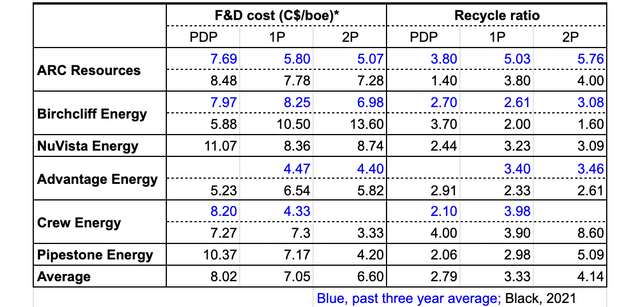
Measuring Growth
Production Growth
Barring the emerging Clearwater play participants, Montney pure-play E&P companies are perhaps the fastest growers in Canadian oil and gas patch. For example, ARC Resources was able to grow production at a CAGR of 15.4% from 2013 to 2021 and plans to further expand output by an additional 13.4% in 2022.
- Pipestone and NuVista plan to grow production by some 30% this year. Crew Energy looks forward to a 21% expansion of its production.
- Advantage Energy appears to place emphasis on an organic and/or acquisitive initiative to expand the weight of liquids, while keeping production growth at ~8% in the year.
- Birchcliff seems to be content with a flat production profile. It is estimated to pull in C$920-940 million in free funds flow in 2022 from its unhedged production; however, it budgeted only C$240-260 million of upstream capital expenditures, with a focus on the redemption of all outstanding series-A and series-C preferred shares by the end of 3Q2022 and zero total debt by 4Q2022.
Table 4. Production growth outlook of Montney pure-play E&P companies (Laurentian Research based on data sourced from Seeking Alpha and company financial filings)
Reserves
Without sufficient reserve underpinning, a growth spurt may turn out to be short-lived. It is thus important to compare these Montney players in terms of their respective reserve replacement ratio and reserve life.
- These six Montney pure-plays replaced >119% of the PDP reserves depleted due to production. Birchcliff may have failed to replace its 1P and 2P reserves (due to significant technical revisions) but I am not worried since it has a rather long reserve life.
- These companies have >4 years of PDP reserve and >9 years of proven reserve backing, which in my opinion offer an adequate growth runway. Except for ARC Resources, the rest of the pack have a >23 year 2P reserve life (Table 5).
Table 5. Reserve life and 2021 reserve replacement if PDP, 1P and 2P reserves of pure-play Montney E&P companies (Laurentian Research based on data sourced from Seeking Alpha and company financial filings)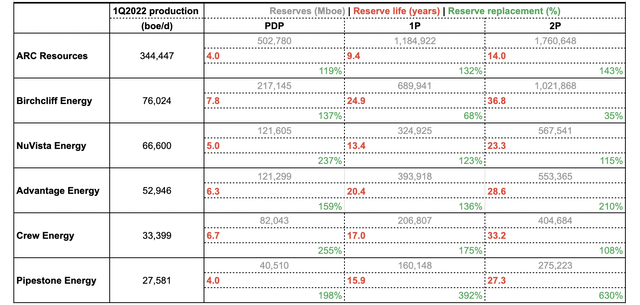
Integrating Various Variables
A barrel of oil equivalent production may generate varying quantities of profit for different operators, depending on the combination of operational variables as described in the afore-given equation. In terms of profitability, the Montney pure-play stocks are ranked in Table 6.
- That Pipestone, ARC and NuVista rank high is expected, considering their high profitability and rapid growth. It doesn’t surprise me either that Birchcliff ranks the lowest, given its low margins and close to nil growth.
- The ranking of Advantage as well as Crew is negatively impacted by their low condensate cut and resultant low margins. To that end, Crew Energy intends to drive down its unit costs for higher margins; if economies of scale defeats inflation, the company may catch up with the ranking of NuVista. Advantage is working on increasing the weight of liquids in its production mix for better price realization and higher margins (Fig. 2).
Table 6. Ranking the Montney pure-play E&P companies (Laurentian Research compiled from Seeking Alpha and company financial filings) Fig. 2. Scatter plot of recycle ratio vs. production growth rate of Montney pure-play stocks (Laurentian Research based on data sourced from Seeking Alpha and company financial filings)
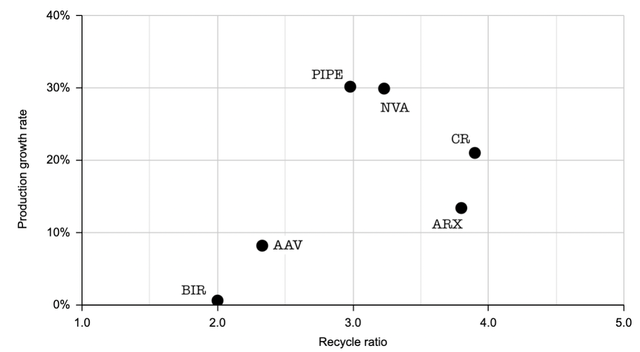
Relative Valuation
The Montney pure-play stocks are compared in Table 7 with regard to their reserves-based net asset value.
- By comparing the share price as of June 10, 2022, with the corresponding 1P NAV, we find Birchcliff and Pipestone seem to be cheaper than the rest of the pack, ARC Resources is clearly on the expensive side, and NuVista, Advantage and Crew are priced between their respective 1P and 2P NAV.
Table 7. Per-share NAV of Montney pure-play stocks, as compared with the current share prices (Laurentian Research based on data sourced from Seeking Alpha and company financial filings)
Investor Takeaways
Energy stock pickers may follow the systematic, holistic method as outlined in this article, with the benefit of dodging common potholes such as monofactorial decisioning and avoiding being swayed by misleading and confusing stock promoters.
Our approach leads to a number of findings about the Montney pure-play stocks:
- Pipestone Energy stands out with regard to asset quality, growth prospect, and margin of safety, while NuVista Energy deserves an honorable mention.
- Birchcliff and Advantage do not appear to be so impressive in terms of margins and growth outlook, even though the former may seem cheap. Crew Energy fares decently in margins and growth but it is relatively expensive.
- ARC Resources has respectable margins and growth rate. However, the stock is not cheap relative to peers, probably as a result of its popularity among newly-arriving generalist investors who tend to gravitate toward large-cap names.
This stock screening paves the way for further in-depth examination of select Montney pure-plays.


Be the first to comment